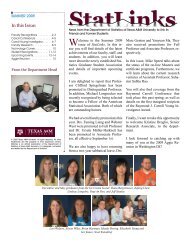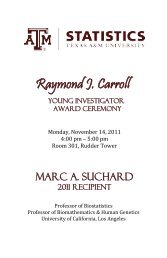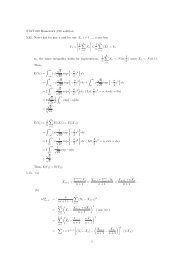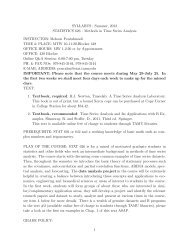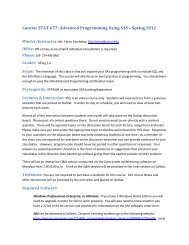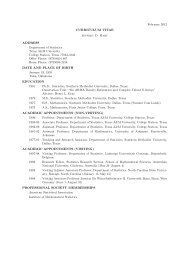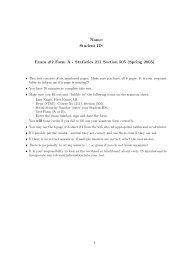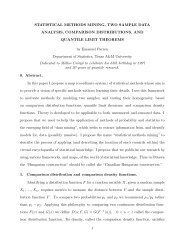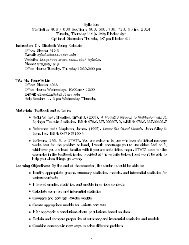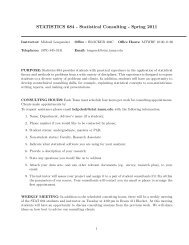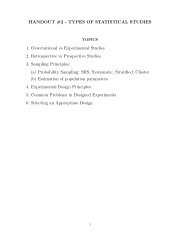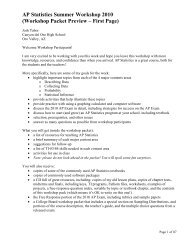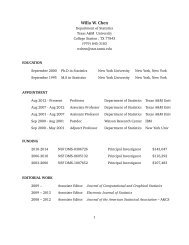DATA MINING, STATISTICAL METHODS MINING AND HISTORY ...
DATA MINING, STATISTICAL METHODS MINING AND HISTORY ...
DATA MINING, STATISTICAL METHODS MINING AND HISTORY ...
Create successful ePaper yourself
Turn your PDF publications into a flip-book with our unique Google optimized e-Paper software.
<strong>DATA</strong> <strong>MINING</strong>, <strong>STATISTICAL</strong> <strong>METHODS</strong> <strong>MINING</strong><br />
<strong>AND</strong> <strong>HISTORY</strong> OF STATISTICS<br />
by Emanuel Parzen<br />
Department of Statistics, Texas A&M University<br />
College Station, TX 77843-3143<br />
0. Abstract.<br />
The emerging field of “data mining” is (according to Pregibon (1996)) a blend of<br />
statistics, artificial intelligence, and database research. It is projected to be a multibillion<br />
dollar industry by the year 2000.<br />
I propose the name “statistical methods<br />
mining” for the process of developing (and marketing) various maps of the world of<br />
statistical knowledge in order to apply to data mining the enormous virtual encyclopaedia<br />
of statistical knowledge that exists in the literature. I propose that planning modern<br />
core, applied, and computational statistical activities should be based on statistical history<br />
whose mottos are “the purpose of statistical computing is insight not numbers”<br />
and “the purpose of statistical history is insight (about future influences) not details (of<br />
past influences)”. The goal of statistical methods mining is to promote the optimum<br />
practice of analysis of diverse (possibly massive) data sets by enabling researchers in<br />
all fields to be made aware that statisticians have important roles to play to provide<br />
expertise about classical and modern statistical methods, theory, practice, applications,<br />
and computational techniques for data mining and statistical inference (extraction of<br />
information and identification of models from data). Contents of this paper are: 1.<br />
Future of statistics is bright, future of statisticians needs planning; 2.<br />
What went<br />
wrong in the recent history of statistical science; 3. Balancing core research and interdisciplinary<br />
research; 4. Statistical education and statistical modeling are analogous<br />
1
iterative cycles; 5. Statistical history was never neglected in past thinking about the<br />
future of statistics.<br />
1. Future of statistics is bright, future of statisticians needs planning<br />
Why should the future of statistics, statisticians, statistical methods, and statistical<br />
science deserve to be discussed at an Interface Symposium whose themes are data<br />
mining and the analysis of massive data sets?<br />
I believe that data mining requires a diversity of scientific, computing, statistical,<br />
and numerical analytical skills to provide visual (graphical) diagnostic presentations<br />
that can be used to make decisions and discover relations between variables. In order<br />
to accurately distill information, we need to apply and integrate the extensive range of<br />
classical and modern statistical methods. We propose that researchers in data mining<br />
and massive data set analysis can benefit from statistical methods mining which I define<br />
as providing a vision of the diversity of statistical methods which enables one to defer<br />
learning their details until they are used in applications. A brilliant example of such a<br />
paper is Elder and Pregibon (1996).<br />
I believe that we need to plan the future of statistics and statisticians in order<br />
to (1) stimulate a new explosion of statistical science, (2) explore analogies between<br />
probability methods (to describe the population or “infinite” data sets) and statistical<br />
methods for massive data sets, and (3) stimulate educational opportunities for applied<br />
researchers who use some statistical techniques, and for statisticians who work with<br />
non-statisticians using statistical methods.<br />
I believe we need to plan (1) the future of statistical methods, in a world over-<br />
2
whelmed with data, and (2) the future of statistical education and practice, in a world<br />
where computers and statistical computing packages can provide engineers, scientists,<br />
managers, professionals, and the public with technical proficiency in statistical methods<br />
which the health and prosperity of society increasingly requires and rewards.<br />
The future of statisticians must be planned, not forecasted.<br />
Statistical methods<br />
mining seeks to provide the vision and expertise that can prevent statistical computing<br />
from being used to unwisely apply statistical methods to reach faulty conclusions.<br />
Statisticians must plan for their future to avoid looming troubles (outlined by Jon<br />
Kettenring, President of the American Statistical Association, in Amstat News May<br />
1996, p. 3):<br />
Other disciplines and professions are seizing our opportunities (to teach introductory<br />
statistics, to make quality job one, to mine data, to analyze massive data sets).<br />
Our graduate statistics programs need improvements to attract and train bright<br />
statisticians for successful careers as “whole” statisticians (see Kettenring (1995)) who<br />
can balance applied statistics (jointly practiced with researchers in other disciplines)<br />
and core (theoretical and mathematical) statistics.<br />
In order for statisticians to be important players in science and technology and<br />
to have good jobs and careers, statisticians should continuously improve their public<br />
relations. Current image is described by Kettenring (1996): “The public jokes about<br />
us. Employers do not see us as idea people and ‘money makers’. Key decision makers<br />
forget or do not know what we have to offer.”<br />
3
2. What went wrong in the recent history of Statistical Science<br />
In the 21st century every individual, every organization, every discipline is expected<br />
to prepare formal plans for the future which justify their economic (not just<br />
their scholarly) relevance in a world of downsizing and outsourcing. To plan for the<br />
future of statistics and statisticians we propose the use of “statistical methods mining”<br />
based on “statistical historical thinking”, defined as the history of statistical applications,<br />
methods, theory, computations, and science, studied as guides to planning future<br />
influences rather than study of past influences.<br />
We can identify the outstanding fact about the history of American statistics<br />
(according to ads for the American Statistical Association 30 minute documentary video<br />
“Statistical Science: 150 Years of Progress”); it is the explosion of statistical science<br />
that occurred around World War II. We propose planning that the next outstanding<br />
historical event will be the explosion of statistical methods mining (around the year<br />
2000).<br />
The American Statistical Association was founded in 1839 in Boston by intellectuals<br />
who wanted to improve the world by studying social problems and wanted to<br />
use statistics as a “tool” to privately collect and interpret data relevant to the social<br />
sciences. Billard (1997) gives a brilliant account of the history of J.A.S.A. until<br />
1939. The Institute of Mathematical Statistics was founded in 1935 (Hogg (1986) and<br />
Hunter (1996)) by statisticians in universities and industry; they wanted to be experts<br />
on statistical methods and on mathematical statistics (the mathematical study of the<br />
methods used to analyze data).<br />
During the World War II years 1940-1945 the mathematical statisticians were<br />
4
able to use their unique talents to make tremendous contributions to the war effort<br />
(by research on war problems and the education of workers in industry in methods of<br />
quality control). In the period 1945-1970 federal research grants and the entrepreneurial<br />
leaders of the 1950-1960 generation of mathematical statisticians built great university<br />
departments of mathematical statistics focused on discipline generated research and<br />
graduate education.<br />
It is my opinion that we need to worry about planning today because of leadership<br />
failures by the 1950-1960 generation of leading university statisticians. I accuse them<br />
of failing to seize opportunities to develop “swinging” statistics programs interacting<br />
with and serving other disciplines. Many anecdotes can be told about negative behavior<br />
that happened among statisticians.<br />
There is much positive behavior by statisticians. The Committee on Applied and<br />
Theoretical Statistics of the National Research Council, and the National Institute of<br />
Statistical Sciences at Research Triangle Park in North Carolina (inspired by Okin and<br />
Sacks (1990)), deserve credit and appreciation for organizing activities that demonstrate<br />
how research by mathematical statisticians could be oriented towards discipline<br />
generated problems and aimed at applicable methods for important applied interdisciplinary<br />
research problems.<br />
How can academic statisticians plan for more improvements? We need leadership<br />
to develop ways of defining the frontiers of research which would mentor statistical<br />
faculty to integrate scholarship in core (discipline generated) research, applied research,<br />
and computer science. We need to award prizes to recognize outstanding achievements<br />
in integrating core and outreach research (such as the ASA Wilks Award and the Texas<br />
5
A&M Parzen Prize).<br />
Statistics departments in the 1960s were slow to seek interdisciplinary links with<br />
computer science departments to help develop computational statistics. To raise our<br />
historical consciousness about computational statistics and statistical computing we<br />
need to teach the history (Goodman (1994)) of the Interface Foundation and the annual<br />
symposiums on the Interface of Statistics and Computer Science.<br />
As a historical note on failures of academic statistical leadership we should include<br />
in our curriculum history of the development of statistical software packages. The SPSS<br />
statistical computing system originated in the 1960s among social science graduate<br />
students at Stanford University without any Statistics Department faculty member<br />
being aware that it was happening.<br />
What went wrong in the golden age of mathematical statistics departments is<br />
stated by George Box (1980) in his discussion of a report on “Preparing Statisticians<br />
for Careers in Industry”; he writes that statistical core research and graduate education<br />
went wrong by ignoring the history of the influence of important practical problems<br />
in the development of general statistical methods. We list in Table A the examples<br />
quoted by Box.<br />
The problem of introductory statistical education is to change the attitude of students<br />
that statistics is their least relevant course, with no relation to their career goals.<br />
Working engineers report being ignorant of statistics, despite having had a course in<br />
statistics. The blame for this disaster is often assigned to academic core (mathematical)<br />
statisticians, and the solution is alleged to be “outreach” (teach statistics through<br />
relevant applications and deny any relation to mathematical thinking). There are many<br />
6
developments in progress (for example, Newton and Harville (1997)) that demonstrate<br />
that statistical computing will provide curricula with more consumer satisfaction. As<br />
we attempt to modernize statistical curricula, I recommend an approach based on<br />
teaching statistical methods mining and advertising the need to involve professional<br />
statisticians in the broad range of applied statistical practice, while making clear that<br />
there is a discipline of statistics with core versions of methods that are elegant and<br />
applicable.<br />
3. Balancing core research and interdisciplinary research<br />
I define core statistical research to be about mathematically synthesizing ideas<br />
drawn from many analogous applications.<br />
The goal is to create general statistical<br />
methods that provide technology transfer between statistical innovations arising in different<br />
disciplines that apply statistical methods. Education in core statistics is needed<br />
to teach methods that are elegant and applicable, and help statisticians promote the<br />
case for their expertise to be part of teams in the broad range of applied statistical<br />
practice.<br />
Statistical historical thinking teaches us that every core statistical method began<br />
with real practical problems which stimulated theoretical problems (discipline generated<br />
problems) for theoretical study. Can statisticians plan their futures if the history<br />
of the stimulus of applied research to core research is not an explicit part of our research,<br />
education, service, public relations? We need to continuously mentor “whole<br />
statisticians” who achieve in their careers a balance between applications (applied research),<br />
theory (abstract core research), and computing. We need to award prizes to<br />
7
continuously increase recognition by scientific and academic publics (and academies of<br />
science) of the roles and existence of statisticians as “experts about the discipline and<br />
practice of statistics”.<br />
A bright future for statistics requires that individual statisticians practice the<br />
principle of continuous improvement, emphasized by Ed Deming, which recommends<br />
to decision makers that every action should be judged by how well it prepares you for<br />
subsequent actions, and how well it is based on knowledge (data) rather than opinions.<br />
An important area of planning for the future is designing statistics graduate curricula.<br />
In many statistical programs when past graduates are polled about what courses<br />
they found most valuable for their careers, they reply that they found very useful the<br />
courses on classical applied parametric statistical methods and found no use at all for<br />
their courses on probability and mathematical statistics. What are the implications for<br />
the future?<br />
Students should be informed that they need theory courses to prepare for multiple<br />
careers. They should learn classical statistics, computational statistics, modern statistical<br />
inference (modern nonparametric statistical methods) as part of a balance among<br />
core, applied, and computational statistics which helps educate “whole statisticians”.<br />
To educate whole statisticians, I propose an approach which teaches probability<br />
and mathematical statistics not as theory (with emphasis on proofs of well known theorems)<br />
but as operational skills for “hands on theory ” needed to develop and evaluate<br />
new statistical methods; I believe a suitable name for this type of course is “mathematical<br />
statistics for non-mathematical statisticians”. We list in Table C some of the<br />
great theorems every statistician should know.<br />
8
One can demonstrate a strong link between the history of statistics and motivating<br />
statisticians to have a consumer level operational knowledge of probability and<br />
mathematical statistics.<br />
In “Breakthroughs in Statistics”, an excellent collection of<br />
historically significant papers, edited by Johnson and Kotz (1991), Beran writes (p.<br />
566) in his introduction to Efron’s paper on bootstrap: “By the late 1970’s theoretical<br />
workers in robust statistics and nonparametrics were familiar with estimates as statistical<br />
functionals–that is, as functions of the empirical cdf. This background prepared<br />
the way for subsequent interpretation and analysis of a bootstrap distribution as a<br />
statistical functional.”<br />
In a review of some of the many books recently published on the history of statistics,<br />
Feinberg (1992) describes two approaches, externalism and internalism. The external<br />
approach looks to the social roots and larger intellectual issues causing developments.<br />
The internal approach looks to the technical outcomes of developments, details<br />
of formulas and proofs.<br />
In my approach to the study of the history of statistics, which views it as a guide<br />
to statistical methods mining and planning modern core, applied, and computational<br />
statistical research activities, I propose that two kinds of skill need to be balanced:<br />
1. technical competence (analogous to internal skills), hard work to accomplish goals<br />
and implement decisions;<br />
2. vision to imagine alternative courses of action (analogous to external skills), inspiration<br />
to infer information about where to guide one’s technical power.<br />
(I am inspired by the two kinds of skills which I once heard the great entrepreneur<br />
Steve Ross state that he looked for, and found hard to find, as he tried to recruit great<br />
9
managers of enterprises).<br />
As an example of teaching graduate students how to balance technical and vision<br />
skills, one should teach skills about what a theorem says, and vision to recognize when<br />
the theorem can play a significant role in solving problems.<br />
4. Statistical education and statistical modeling are analogous iterative<br />
cycles<br />
Practicing statistical methods mining requires understanding about strategies for<br />
solving statistical problems and learning statistical methods. We propose that both<br />
require a cycle of steps which one usually repeats (iterates) several times before reaching<br />
a satisfactory conclusion.<br />
The cycle of statistical model building (whose motto is “no model is true, only<br />
useful”) consists of four stages:<br />
Stage 1 (S): Specify very general class of models.<br />
Stage 2 (I): Identify tentative parametric model.<br />
Stage 3 (E): Estimate parameters of tentative models.<br />
Stage 4 (T): Test goodness of fit, diagnose improved models.<br />
The PDCA cycle of statistical problem solving (called in quality circles Shewhart’s<br />
or Deming’s wheel) consists of four stages:<br />
Stage 1 (P): Plan; pose the question, form expectations.<br />
Stage 2 (D): Do; collect the data, make observations.<br />
Stage 3 (C): Check; analyze the data, compare observations and expectation.<br />
Stage 4 (A): Act; interpret the results, find the best theory or decision that<br />
10
fits the data.<br />
We think of both cycles as EOCI (Expect, Observe, Compare, Interpret).<br />
Reformers of mathematics education recommend that teachers should communicate<br />
the four aspects of learning which cognitive sciences recommend for success:<br />
1. simple recall,<br />
2. algorithmic learning,<br />
3. conceptual learning, and<br />
4. problem solving strategies.<br />
In statistical teaching we can make these cognitive concepts more concrete by<br />
teaching that statistical concepts (such as the sample mean or sample variance) have<br />
three aspects:<br />
1. how to define it (mean of sample distribution);<br />
2. how to compute it (average the sample quantile function (values arranged in<br />
increasing order));<br />
3. how to interpret it (estimate location parameter of sample).<br />
The fourth aspect of statistical learning consists of ideas about combining concepts to<br />
conduct an iterative statistical investigation whose output is data models, which can<br />
be applied to simulate more data with the same distribution as the originally observed<br />
data.<br />
5. Statistical history was never neglected in past thinking about the future<br />
of statistics<br />
This paper is about the future of statistics in the 21st century and the potential of<br />
11
statistical methods mining to stimulate a new explosion of statistical science. I would<br />
like to emphasize that we should read proceedings of past conferences on the future of<br />
statistics. We give some examples to show that historical thinking was never neglected.<br />
From the Proceedings of the Conference on Directions for Mathematical Statistics,<br />
organized by Ghurye (1975) at the University of Alberta in 1974, we quote<br />
Mark Kac (p. 6) and Herbert Robbins (p. 116, a provocative essay “Wither mathematical<br />
statistics?”). Kac: Johannsen took a large number of beans, weighed<br />
them and constructed a histogram; the smooth curve fitted to this histogram<br />
was what my teacher introduced to us as the Quetelet curve. That was my first<br />
encounter with the normal distribution and the name Quetelet.<br />
At this time I would like to make a small digression which has its own point to<br />
make.<br />
Quetelet was an extraordinarily interesting man, who was a student of<br />
Laplace and was the first to introduce statistical methodology into social science<br />
(even though he was trained as an astronomer); he was also the author of some<br />
early books in the area (Lettres sur la Théorie des Probabilités, 1846; Physique<br />
Sociale, 1st ed. 1835, 2nd ed. 1869; Anthropométrie, 1870). It might interest<br />
some of you to know that Quetelet was private tutor to the two princes of Saxe-<br />
Coburg, one of whom Prince Albert, later became Queen Victoria’s Consort. He<br />
was the first major governmental figure to try to introduce some kind of rational<br />
thinking into the operations of the government, and thus may be considered as<br />
the forefather of Operations Research. Now, the point of this digression is that<br />
if you look back at this connection between Astronomy and Operations Research,<br />
via Laplace, Quetelet and Prince Albert, you will realize the significance of the<br />
12
Danish proverb I quoted at the beginning (“it is difficult to predict, especially the<br />
future”).<br />
Anyway, coming back to Johannsen, he argued that if all individual characteristics<br />
are inheritable, then if we take the small beans and plant them, take the large<br />
ones and plant them, and plot separately the two histograms for the progeny of<br />
the small and the large beans, then we should again obtain Quetelet curves, one<br />
centered around the mean weight of the small beans used as progenitors and the<br />
other around that of the large ones. Now, he did carry out such an experiment<br />
and did draw those histograms, and discovered that the two curves were almost<br />
identical with the original one. Actually, there was a slight shift to the left for<br />
the small ones, so that by repeated selection one could separate out the two<br />
populations. Of course, we now know that it is possible to distinguish between<br />
the genetic and the environmental factors, because the mean is controlled by the<br />
genetic factor while the variance is controlled by the environmental.<br />
I have mentioned the above example because it illustrates a kind of unity of scientific<br />
thought: here was a basic problem in biology which was solved by a rather<br />
simple idea, which on closer analysis turns out to have an underlying mathematical<br />
foundation; and when one thinks some more about it, one is able to put a<br />
great deal of quantitative flesh on this extraordinarily interesting and impressive<br />
qualitative skeleton.<br />
Robbins: Mathematical statistics is relatively new.<br />
Two sources that I have<br />
found most informative concerning its ‘early’ history are Karl Pearson’s three-<br />
13
volume work on the life, letters and labours of Sir Francis Galton, and the British<br />
statistical journals during the period 1920–40 that contain the famous controversies<br />
involving R. A. Fisher, J. Neyman and E. S. Pearson, and their sometimes<br />
bewildered contemporaries of lesser rank. It would be a most useful thing, especially<br />
during times when nothing really new and important seems to be going on,<br />
for students and professors to acquaint themselves with at least this much of the<br />
historical background of their subject. An intense preoccupation with the latest<br />
technical minutiae, and indifference to the social and intellectual forces of tradition<br />
and revolutionary change, combine to produce the Mandarinism that some<br />
would now say already characterizes academic statistical theory and is more likely<br />
to describe its immediate future.<br />
Planning the future of statistics has been discussed by Tukey (1962), Watts (1968),<br />
Healy (1978), and Mc Pherson (1989).<br />
Our research (Parzen (1991)) on unification of statistical methods can be interpreted<br />
to be about maps of statistical methods and statistical methods mining.<br />
In future<br />
papers we will describe our ideas for maps of statistical methods using three coordinates:<br />
data notation; whole statistician (application, theory, computation); data inference.<br />
Parzen (1993) discusses the interaction between theory and computation (hammers)<br />
and applications (nails). Examples of the role of statisticians: apply (1) the “hammer”<br />
of wavelets to the “nails” of nonparametrically estimating for real data changepoints<br />
and regressions (see Ogden (1997)), and (2) the hammer of linear programming to<br />
estimate regression quantiles.<br />
14
Bibliography<br />
Billard, Lynne. (1996) “A Voyage of Discovery,” Journal of the American Statistical<br />
Association, Vol. 92, No. 437, Presidential Address. pp. 1–12.<br />
Box, G. E. P. (1980) Comment (Preparing statisticians for careers in industry: report<br />
of ASA Section on Statistical Education committee on training of statisticians for<br />
industry). The American Statistician, 34, 65–80.<br />
Elder, John and Daryl Pregibon. (1996) “A statistical perspective on knowledge<br />
discovery in databases” in Usama M. Fayyad, G. Piatetsky-Shapiro, P. Smyth,<br />
R. Uthurusamy, Advances in Knowledge Discovery and Data Mining, MIT Press,<br />
83–113.<br />
Fienberg, S. E. (1992)<br />
A brief history of statistics in three and one-half chapters: a<br />
review essay. Statistical Science 7, 208–225.<br />
Ghurye, S. G. (1976)<br />
Proceedings of the conference on directions for mathematical<br />
statistics. Advances in Applied Probability Supplement, 7, September 1975.<br />
Goodman, Arnold (1975) “American Statistical Association,” Encyclopedia of Information<br />
Science and Technology, Volume 1 (Edited by Jack Belzer, Albert Holzman<br />
and Allen Kent), Marcel Dekker.<br />
Goodman, Arnold, (1994)<br />
“Interface Insights: From Birth into the Next Century,”<br />
Proceedings of Interface ’93: 25th Symposium on the Interface of Computing Science<br />
and Statistics, Interface Foundation of North America.<br />
Healy, M. J. R. (1976) Is statistics a science? Journal of the Royal Statistical Society,<br />
15
Series A, 141, pp. 385–393.<br />
Hogg, R. V. (1986) On the origins of the Institute of Mathematical Statistics. Statistical<br />
Science 1, 285–291.<br />
Hunter, P. W. (1996) Drawing the boundaries: mathematical statistics in 20th-century<br />
America. Historia Mathematica, 23, 7–30.<br />
Kettenring, J. R. (1995) What industry needs (Symposium on Modern Interdisciplinary<br />
University Statistics Education). The American Statistician, 49, 2–4.<br />
Kettenring, Jon. (1996)<br />
“Strategic Planning – The Future of Statistics,” AMSTAT<br />
News, American Statistical Association, May 1996, No. 231, p. 3.<br />
Kotz, S. and N. L. Johnson, (eds.). (1991)<br />
Breakthroughs in Statistics. Vol. I, II.<br />
Springer, New York, Berlin.<br />
McPherson, G. (1989) “The Scientists’ View of Statistics–A Neglected Area,” Journal<br />
of the Royal Statistical Society, A, 152, 221–240.<br />
Newton, H .J. and Jane Harville. (1997) StatConcepts: A Visual Tour of Statistical<br />
Ideas. Duxbury.<br />
Ogden, R. Todd. (1997) Essential Wavelets for Statistical Applications and Data<br />
Analysis, Birkhäuser, Boston.<br />
Olkin, I. and Sacks, J. (1990) “Cross-disciplinary research in the Statistical Sciences,”<br />
Institute of Mathematical Statistics Panel Report. Statistical Science, 5, 121–146.<br />
Parzen, Emanuel. (1991) “Unification of Statistical Methods for Continuous and<br />
16
Discrete Data,” Proceedings Computer Science–Statistics INTERFACE ’90, (ed.<br />
C. Page and R. LePage), Springer Verlag: New York, 235–242.<br />
Parzen, Emanuel. (1993) “History of Statistics in Real Time: Hammers and Nails”,<br />
Proceedings Computer Science-Statistics, Interface Foundation, Vol. 24, 602–608.<br />
Pregibon, D. (1996) Data mining. Statistical Computing and Graphics Newsletter, 7,<br />
p. 8.<br />
Tukey, J. W. (1962) The future of data analysis. Ann. Math. Statist. 33, 1–67.<br />
Watts, D. G. (1968) The Future of Statistics, Academic Press: New York.<br />
17
Table A.<br />
(1980))<br />
Practical Problems Motivating General Concepts (George Box<br />
Investi-<br />
Practical Problem gator Derived General Concept<br />
Analysis of Asteroid Data. How<br />
far is it from Berlin to Potsdam?<br />
Are planetary orbits randomly distributed?<br />
Gauss<br />
Daniel<br />
Bernouilli<br />
Least squares<br />
Hypothesis testing<br />
What is the population of France? Laplace Ratio estimators<br />
How to handle small samples of<br />
brewery data.<br />
Improving agricultural practice by<br />
using field trials.<br />
Do potato varieties and fertilizers<br />
interact?<br />
Accounting for strange cycles in<br />
U.K. wheat prices.<br />
Economic inspection (of ammunition).<br />
Gosset<br />
Fisher<br />
Fisher<br />
Yule<br />
Wald<br />
Barnard<br />
t test<br />
Design of experiments<br />
Analysis of variance<br />
Parametric time series models<br />
Sequential tests<br />
Need to perform large numbers of Wilcoxon<br />
statistical tests in pharmaceutical<br />
industry before computers were available.<br />
Nonparametric tests<br />
18
Table B: Disciplines Active in<br />
Statistical Collaborative Research<br />
Health Sciences<br />
Medicine<br />
Public Health and Epidemiology<br />
Biostatistics<br />
Cancer Clinical Trials<br />
AIDS Clinical Trials<br />
Life Sciences<br />
Biology<br />
Ecology<br />
Fisheries and Wildlife<br />
Environmental Sciences<br />
Toxiocolgy and Pharmacology<br />
Genetics<br />
Entomology<br />
Forest Science<br />
Physiology<br />
Agriculture<br />
Animal Science<br />
Soils and Crop Sciences<br />
Agricultural Economics<br />
Veterinary Medicine<br />
Food Science<br />
Behavioral and Social Sciences<br />
Psychology, Cognitive Sciences<br />
Economics, Econometrics<br />
Education<br />
Sociology<br />
Political Science<br />
Sample Survey<br />
Government Statistics<br />
Physical, Chemical, Earth and Atmospheric Sciences<br />
Chemistry, Chemometrics<br />
Geology, Geophysics<br />
Physics, Astronomy, Chaos, Fractals<br />
Meteorology, Climate Research<br />
Oceanography<br />
Engineering and Mathematical Sciences<br />
Engineering<br />
Artificial Intelligence<br />
Neural Nets<br />
Massive Data Sets Analysis<br />
Operations Research and Reliability<br />
Mathematics<br />
Signal Processing<br />
Image Analysis and Pattern Recognition<br />
Industrial Statistics<br />
Defense Statistical Standards<br />
Hydrology<br />
Business Administration<br />
Finance<br />
Forecasting<br />
Insurance<br />
Law<br />
19
Table C: Some statistical great truths (theorems can be practical)<br />
Introductory graduate statistics courses should try to communicate some of the<br />
great statistical truths that demonstrate the important role of theory in the practice<br />
of statistics and data analysis.<br />
A. Why are sample sizes of opinion polls always approximately 1100, no mater how<br />
large the population being polled<br />
B. Law of averages (rate of decrease of variances of sample averages)<br />
C. Bell shaped curve (normal distribution)<br />
D. Why does statistical inference work; limit theorems for order statistics, extreme<br />
values.<br />
E. Time series analysis; understand persistence (correlation) to diagnose spurious<br />
non-zero correlation, spurious non-zero mean, and spurious trend.<br />
F. Functional statistical inference: density estimation to diagnose spurious zero correlation,<br />
spurious lack of relationship.<br />
G. Accuracy and reliability of lab tests (Bayes reasoning).<br />
H. A statistical theorem of which many methods are extensions. To cut a path through<br />
the jungle of statistical methods, one needs analogies between analogies which make<br />
it easy to comprehend a diversity of methods. I claim that a unifying analogy is<br />
provided by the basic identities: for random variables X, Y and constant θ;<br />
E [ |X − θ| 2] = VAR[X]+{E[X]−θ} 2<br />
VAR[Y ]=E[VAR[Y |X]] + VAR[E[Y |X]].<br />
I. What is a Brownian Bridge, and what are their applications in statistical theory<br />
and practice.<br />
20
Table D<br />
Glossary of Modern Statistical Methods Mining<br />
Robust and resistant<br />
Exploratory data analysis<br />
Generalized linear models<br />
EM algorithm<br />
Loglinear models<br />
Bootstrap<br />
Borrowing strength<br />
Regularization<br />
Shrinkage<br />
Simpson’s paradox<br />
Automatic modeling criteria<br />
Density estimation<br />
Projection pursuit<br />
Decision trees, CART<br />
Adaptive splines, MARS<br />
Gibbs sampling<br />
Causal inference<br />
Wavelets<br />
Quantile domain<br />
Long tailed distributions<br />
Changepoint Analysis<br />
Spectral estimation<br />
Time Series Prediction<br />
Kalman filtering<br />
Long memory time series, fractals<br />
Clustering<br />
Neural networks<br />
Data mining<br />
21



